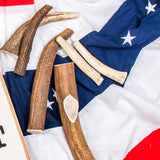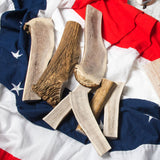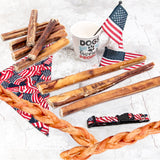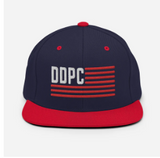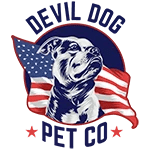Every dog owner knows the scene: you come home to find your favorite shoes transformed into confetti, couch cushions excavated, or baseboards carved into modern art. Here's the unfiltered truth—destructive chewing isn't a "bad dog" problem, it's an unled dog problem.
Key Takeaways
- The best bones for dogs include naturally shed elk antlers, yak cheese chews, and single-ingredient bully sticks.
- These bone options are safe, long-lasting, and do not pose splintering risks.
- Always select bones that are larger than your dog's mouth to ensure safety.
- Supervising your dog during chewing sessions is essential to prevent accidents.
- Destructive chewing is a result of unmet needs, not bad behavior.
Table of Contents
- Understanding Your Dog's Chewing Style and Needs
- Key Criteria for Choosing the Best Bones for Dogs
- Common Types of Bones and Chews for Dogs
- Side-by-Side Comparison: Popular Dog Bone Types
- Traits of the Best Dog Chew Bones
- Practical Tips for Giving Bones to Dogs
- Frequently Asked Questions About Dog Bones
- Choosing the Perfect Bone for Your Dog
- Your Commitment to Safe, Beneficial Chewing
Dogs chew because they're hardwired to. It's how they explore the world, manage anxiety, keep teeth clean, and burn mental energy. The question isn't whether your dog will chew—it's whether you'll give them something worthy of those powerful jaws or let them choose their own targets.
Finding the best bones for dogs means understanding your dog's chewing style, prioritizing safety over convenience, and matching the right chew to their individual needs. Power chewers need different tools than gentle gnawers, and what works for a teething puppy won't cut it for a 70-pound adult with serious jaw strength.
Understanding Your Dog's Chewing Style and Needs
Chewing Intensity: From Gentle to Destructive
Not all chewers are created equal. Gentle chewers nibble and lick—think senior dogs or toy breeds who treat everything like fine china. Moderate chewers work steadily through treats without destroying furniture—most Labs, Goldens, and mixed breeds fall here. Power chewers are the heavy artillery—German Shepherds, Pit Bulls, Rottweilers, and working breeds that can demolish a rawhide in minutes.
Chewing Style Assessment:
- Gentle: Prefers soft treats, chews slowly, rarely destroys toys
- Moderate: Finishes bully sticks in 30-45 minutes, occasional furniture nibbling
- Power: Destroys "indestructible" toys, chews through bones quickly, strong jaw pressure
Age matters just as much as intensity. Puppies need softer options that won't damage developing teeth, while seniors benefit from chews that won't strain worn molars. Adult dogs in their prime can handle the toughest natural chews when sized correctly.
Why Supervision Matters More Than Marketing Claims
Here's where most owners fail: they hand over a chew and walk away. Every chew session requires supervision, especially during the first few uses. Dogs can break off large chunks, wear chews down to swallowable sizes, or develop cracks that create sharp edges.
Marine Corps Lesson: "Trust but verify." Even the safest chew becomes dangerous when it's too small, too worn, or mismatched to your dog's style. Stay engaged, stay vigilant.
- It becomes small enough to swallow whole
- Sharp edges or cracks develop
- Your dog tries to gulp large pieces
- Excessive slobbering or pawing at mouth occurs
Key Criteria for Choosing the Best Bones for Dogs

Safety: The Non-Negotiable Foundation
The best dog bones balance hardness with safety. Too soft, and power chewers devour them in minutes, potentially causing digestive upset. Too hard, and you risk cracked teeth—a painful, expensive emergency that's entirely preventable. For a selection of safe, natural options, explore our long lasting dog chews.
- Hardness Sweet Spot
- Natural chews should give slightly under extreme pressure but resist casual gnawing. Think elk antler or compressed yak cheese—firm enough to last, forgiving enough to avoid dental trauma.
- Size Selection
- Choose chews longer than your dog's muzzle and too thick to fit between back molars. When in doubt, size up. A chew that seems "too big" is infinitely safer than one that's borderline.
- Ingredient Transparency
- Single-ingredient or minimal-ingredient chews win every time. Avoid anything with artificial colors, preservatives, or mystery "natural flavors." Your dog's digestive system wasn't designed for laboratory chemistry.
Durability: Cost Per Hour of Engagement
The best chew bones for dogs aren't necessarily the cheapest upfront—they're the ones that deliver the most enrichment hours per dollar spent. A $15 elk antler that entertains your dog for three weeks beats a $3 rawhide that vanishes in 20 minutes and potentially causes blockages.
Factor in your dog's specific needs too. Dogs with beef allergies need alternative protein sources. Sensitive stomachs require easily digestible options. Heavy chewers need maximum durability to justify the investment.
Common Types of Bones and Chews for Dogs
Raw Bones: The Traditional Choice
Raw Beef Marrow and Knuckle Bones
Raw beef marrow bones represent the gold standard for natural dog chews. Their dense structure resists splintering while providing rich nutrients—healthy fats, calcium, phosphorus, and trace minerals that support coat health and bone development.
- Naturally sized for medium to large breeds
- Marrow provides mental stimulation and flavor reward
- Dense cortical bone structure prevents dangerous splintering
- Can be frozen to extend chew time and reduce mess
Other Large Raw Bones: Lamb and Beef Options
Lamb shanks and large beef bones offer similar benefits to marrow bones but with different shapes and densities. These work well for dogs who prefer different gripping angles or need variety in their chew rotation.
Avoid entirely: Chicken, turkey, and pork bones. These species produce bones that are too soft when raw and dangerously brittle when cooked. Stick with beef and lamb from animals large enough to produce appropriately sized, structurally sound bones.
Edible Chews and Commercial Alternatives
Bully Sticks: The Digestible Favorite
Single-ingredient beef bully sticks earn their reputation as the best dog bone for dogs with sensitive systems. They're fully digestible, provide high-quality protein, and soften gradually as dogs chew—reducing the risk of large, dangerous chunks. For dogs who need a longer-lasting challenge, try the 12" Ultra Thick Bully Stick or the 12" Braided Bully Stick for extra durability.
- 100% digestible—no blockage risk when properly sized
- Natural dental cleaning action from fibrous texture
- Available in multiple thicknesses for different chew intensities
- Higher cost per chew session compared to longer-lasting options
- Natural beef odor that some owners find objectionable
Pro Tip: Use bully stick holders to prevent choking on the final nub. When the stick becomes small enough to swallow, trade it for a fresh treat—safety over waste every time.
Yak Cheese Chews: The Long-Distance Champion
Himalayan yak cheese chews bridge the gap between digestible treats and long-lasting bones. Made from yak and cow milk, salt, and lime juice, they're virtually lactose-free and provide extended chewing satisfaction for aggressive chewers. For larger dogs or power chewers, consider the Beast Himalayan Dog Chew or the Monster Himalayan Dog Chew for maximum longevity.
The unique manufacturing process—smoking and sun-drying at high altitude—creates a dense, hard texture that softens gradually with saliva. When the final piece becomes too small, you can microwave it into a crunchy puff treat, eliminating waste entirely.
Antlers: Maximum Durability with Caution
Elk and deer antlers represent the best bones for dogs that chew destructively through everything else. Naturally shed each spring, these dense bone structures can entertain power chewers for weeks or months when properly sized. For the toughest chewers, the Jumbo Whole Elk Antler Dog Chew or Extra Large Whole Elk Antler Official Dog Chew are excellent choices.
Antler Benefits:
- Naturally rich in calcium, phosphorus, and trace minerals
- Zero odor, zero mess—perfect for indoor use
- Last 10-20x longer than most commercial chews
- Hypoallergenic—ideal for dogs with protein sensitivities
The hardness that makes antlers so durable also creates their primary risk. Dogs that bite straight down with full force can crack teeth on the dense outer wall. Choose split antlers for newcomers—exposing the softer inner marrow reduces tooth stress while maintaining longevity.
Beef Trachea, Tendons, and Alternative Protein Sources
Natural animal parts offer unique benefits for specific needs. Beef trachea provides glucosamine and chondroitin for joint support while remaining fully digestible. Tendons offer similar joint benefits with a chewier texture that promotes extended gnawing sessions.
- Rich in joint-supporting compounds
- Completely digestible when properly sized
- Novel protein sources for dogs with common allergies
- Strong natural odors that some households can't tolerate
- Can be greasy—may stain fabrics or carpets
Fish skin chews provide omega-3 fatty acids for coat health, while pig ears offer a softer option for gentle chewers. Each serves specific dietary goals beyond simple entertainment.
Synthetic and Rubber Alternatives
Nylon and Rubber Bones: When Natural Isn't Practical
High-quality synthetic bones fill gaps where natural options fall short. Nylon bones work well for teething puppies who need something firm but not overwhelmingly hard. Rubber puzzle toys combine chewing satisfaction with mental stimulation through treat-dispensing mechanisms.
The trade-off is nutritional value—synthetic chews provide entertainment without the mineral content, protein, or dental benefits of natural alternatives. Use them strategically rather than as primary chewing solutions.
Side-by-Side Comparison: Popular Dog Bone Types

| Chew Type | Best For | Duration | Safety Level | Cost Efficiency |
|---|---|---|---|---|
| Raw Beef Marrow | Medium-large power chewers | 2-4 weeks | High (supervised) | Excellent |
| Bully Sticks | All chewer types | 20-60 minutes | Very High | Moderate |
| Yak Cheese | Aggressive chewers | 1-3 weeks | High | Very Good |
| Elk Antlers | Experienced power chewers | 1-3 months | Moderate | Excellent |
| Beef Trachea | Joint health focus | 3-7 days | High | Good |
| Nylon Bones | Puppies, light chewers | Months | High (monitored) | Very Good |
Traits of the Best Dog Chew Bones
Digestibility and Safety Standards
Veterinary nutritionists consistently recommend single-ingredient chews that break down safely in the digestive tract. The best options soften gradually with saliva and stomach acid rather than maintaining rigid hardness that could cause blockages. For more on the benefits and risks of chew treats, see this veterinary resource.
Veterinary Consensus: "Chews should be hard enough to provide dental benefits and mental stimulation, but soft enough to avoid tooth fractures. Natural options that compress under extreme pressure offer the best balance." - Dr. Sarah Chen, Veterinary Dentist
- Progressive Softening
- Quality chews become more pliable as dogs work them, reducing injury risk while maintaining engagement. Bully sticks and yak chews exemplify this ideal behavior.
- Splinter Resistance
- Dense, uniform structure prevents dangerous sharp fragments. Avoid any chew that creates hard, pointed pieces when worn down.
- Appropriate Dissolution Rate
- Chews should wear away slowly enough to provide value but fast enough that swallowed particles pass safely through the digestive system.
Size Appropriateness: The Critical Safety Factor
The healthiest dog bones are sized to prevent swallowing hazards while maximizing chewing satisfaction. This means choosing chews that seem "too big" rather than "just right" to most owners' eyes.
- Small dogs (under 25 lbs): 4-6 inch minimum length
- Medium dogs (25-60 lbs): 6-8 inch minimum length
- Large dogs (60-90 lbs): 8-12 inch minimum length
- Giant breeds (90+ lbs): 12+ inch minimum length
Remember that these are starting points—individual jaw strength and chewing style matter more than weight alone. A 50-pound pit bull needs a larger chew than a 50-pound greyhound due to dramatically different bite pressure and chewing intensity.
Avoiding Dangerous Bone Types
Understanding what not to give your dog is equally important as knowing the best bones for puppies and adult dogs. Certain bone types create unnecessary risks regardless of size or supervision. For more on safe and unsafe chew options, visit this comprehensive guide on safe chewing toys for dogs.
- Cooked bones of any type—heat makes them brittle and prone to splintering
- Chicken, turkey, or pork bones—too soft when raw, dangerous when cooked
- Weight-bearing bones from small animals—insufficient size for safety
- Bones that have been boiled, smoked, or otherwise processed with heat
The science is clear: cooking fundamentally changes bone structure, making even large beef bones prone to creating sharp, dangerous fragments. Stick with raw options from large animals or high-quality processed alternatives like yak chews and bully sticks.
Practical Tips for Giving Bones to Dogs

Tailoring Choices to Individual Dogs
The best bones for small dogs differ dramatically from ideal choices for large breeds, and age creates additional considerations that override size alone. A systematic approach to selection prevents both waste and safety issues.
Age-Specific Recommendations:
- Puppies (8-16 weeks): Soft bully sticks, frozen carrots, puppy-specific teething toys
- Adolescents (4-18 months): Split antlers, medium yak chews, supervised raw bones
- Adults (1-7 years): Full range based on chewing intensity and preferences
- Seniors (7+ years): Softer options, shorter sessions, monitor for dental sensitivity
Breed characteristics matter beyond size. Brachycephalic breeds (bulldogs, pugs) need shorter, thicker chews they can grip effectively. Herding breeds often prefer chews they can carry and position precisely. Terriers typically want something they can "kill" through aggressive shaking and biting.
Introduction Protocol for New Chews
Even the best puppy chew bones can cause problems if introduced incorrectly. A structured introduction process prevents digestive upset and helps you assess safety before committing to unsupervised sessions.
- Initial 15-minute session: Offer the new chew under direct supervision, watching for aggressive biting, proper grip, and interest level
- Monitor for 24 hours: Check for digestive changes, excessive drooling, or behavioral shifts that might indicate problems
- Gradual time increases: Extend sessions by 10-15 minutes every few days until you reach optimal duration
- Establish routine: Most dogs benefit from 2-3 chew sessions per week rather than daily access
Marine Leadership Principle: "Slow is smooth, smooth is fast." Rushing the introduction process creates more problems than it solves. Take time to do it right the first time.
Supervision and Maintenance Protocols
Active supervision means more than glancing over occasionally. Position yourself where you can intervene quickly, keep a high-value treat ready for trading if needed, and know the warning signs that indicate immediate removal.
Chew maintenance extends their lifespan and maintains safety. Raw bones should be refrigerated between sessions and discarded after 3-4 days. Antlers and yak chews can be stored at room temperature but should be inspected for cracks or wear before each use.
Safety Accessories and Chew Holders
Chew holders and safety accessories transform borderline-safe chews into completely secure options. These tools are particularly valuable for the final portions of bully sticks and similar treats that become choking hazards as they wear down.
- Bully stick holders: Secure the final 2-3 inches, preventing swallowing
- Antler holders: Provide grip assistance for dogs with arthritis or jaw issues
- Puzzle feeders: Slow consumption of softer chews, extending engagement time
- Chew mats: Protect floors and provide stable surfaces for messy options
Quality holders pay for themselves quickly by eliminating waste from discarded nubs and reducing choking risks that could result in emergency veterinary visits.
When to Consult Your Veterinarian
Certain situations require professional guidance beyond general safety principles. Don't hesitate to involve your veterinarian in chew selection—their input can prevent serious problems and optimize benefits for your dog's specific health profile.
- Your dog has a history of dental problems or recent dental work
- Digestive sensitivities or food allergies complicate chew selection
- Previous blockages or foreign body surgeries create ongoing risks
- Senior dogs show signs of cognitive decline that might affect judgment
- Any unusual symptoms appear after introducing new chews
Veterinarians can also recommend prescription chews for dogs with specific health conditions. Dental disease, kidney problems, and obesity all influence which chews provide benefits versus risks for individual dogs.
Frequently Asked Questions About Dog Bones
Are raw bones safer than cooked bones for dogs?
Raw bones from large animals are significantly safer than any cooked bone. Cooking fundamentally changes bone structure, making even large beef bones brittle and prone to splintering. Raw beef marrow bones and knuckle bones maintain their natural flexibility and density, wearing down gradually rather than breaking into dangerous fragments.
The key is sourcing: get raw bones from reputable butchers or pet stores that maintain proper refrigeration. Handle them like any raw meat product, refrigerate between sessions, and discard after 3-4 days to prevent bacterial growth.
How do I know if a bone is too hard for my dog?
Test bone hardness using the "thumbnail test"—if you can't make an indent with your thumbnail, the bone may be too hard for your dog's teeth. Watch your dog's chewing style during supervised sessions: excessive force, aggressive straight-down biting, or visible jaw strain indicate the chew is too challenging.
- Appropriate hardness: Gives slightly under extreme pressure, allows gradual wearing
- Too soft: Breaks apart quickly, creates swallowable chunks
- Too hard: No give under pressure, causes jaw fatigue or tooth stress
Age matters significantly—best bones for puppies should be softer than adult options, while senior dogs need gentler choices to accommodate potential dental sensitivity.
What are signs my dog is not tolerating a bone well?
Monitor for both immediate and delayed reactions. Immediate concerns include excessive drooling, pawing at the mouth, difficulty gripping the chew, or unusual chewing patterns that suggest discomfort.
- Aggressive gulping or attempts to swallow large pieces
- Blood on the chew or around your dog's mouth
- Excessive jaw fatigue or difficulty opening the mouth
- Whimpering or signs of oral pain during chewing
Delayed reactions include digestive upset, loose stools, vomiting, or behavioral changes like loss of appetite. Rich marrow bones and new protein sources commonly cause temporary digestive adjustment—introduce gradually and monitor for 24-48 hours after first exposure.
Can puppies and senior dogs have bones, and what types are best?
Both life stages require modified approaches to bone selection. Best puppy chew bones focus on appropriate hardness for developing teeth, while senior options prioritize digestibility and joint comfort.
- Puppies (8 weeks - 6 months)
- Soft bully sticks, split antlers with exposed marrow, and frozen carrots for teething relief. Avoid whole antlers and hard bones until adult teeth are fully erupted around 5-6 months.
- Senior Dogs (7+ years)
- Softer options like beef trachea, standard bully sticks, and yak chews work well. Monitor for dental sensitivity and consider shorter chew sessions to prevent jaw fatigue.
Both groups benefit from increased supervision and shorter initial sessions. Senior dogs may need assistance holding larger chews if arthritis affects their grip strength.
How do I prevent my dog from swallowing large chunks?
Proper sizing prevents most swallowing issues—choose chews significantly larger than your dog's mouth and remove them when they wear down to swallowable size. Training also plays a crucial role in developing appropriate chewing behavior.
Chew holders provide mechanical prevention for items like bully sticks that become problematic as they wear down. Position yourself where you can intervene quickly during chew sessions, and always have a backup treat ready for emergency trades.
Some dogs naturally gulp rather than chew—these individuals need softer, faster-dissolving options like beef trachea or may benefit from puzzle feeders that force slower consumption.
Choosing the Perfect Bone for Your Dog
A Systematic Approach to Selection
The best dog bone for dogs emerges from matching multiple factors rather than following universal recommendations. Start with your dog's chewing intensity, then layer in age, size, dietary restrictions, and household practical considerations.
Selection Priority Order:
- Safety first: Appropriate size and hardness for your dog's jaw strength
- Chewing style match: Gentle, moderate, or power chewer requirements
- Dietary compatibility: Allergies, sensitivities, and nutritional goals
- Practical factors: Odor tolerance, mess management, storage requirements
- Value optimization: Cost per hour of engagement and dental benefits
This framework prevents impulse purchases that end up unused or, worse, create safety hazards. A $3 bully stick that provides 30 minutes of safe engagement offers better value than a $15 antler that sits ignored or causes tooth damage.
Building a Chew Rotation Strategy
Most successful dog owners maintain a rotation of 3-4 different chew types rather than relying on a single option. This approach prevents boredom, provides varied nutritional benefits, and reduces the risk of overexposure to any single ingredient.
Rotation Strategy: "We keep split antlers for weekend entertainment, bully sticks for training rewards, and yak chews for crate time. Our dog Dexter never gets bored, and we've eliminated destructive chewing entirely through strategic variety."
- Daily chews: Softer options like bully sticks for regular dental maintenance
- Weekend entertainment: Longer-lasting antlers or large marrow bones for extended engagement
- Training rewards: High-value, quick-consumption treats that don't interfere with meal schedules
- Anxiety management: Familiar, comforting chews for stressful situations like thunderstorms
Rotate chews weekly or bi-weekly to maintain novelty. Store unused options out of sight to preserve their special appeal when reintroduced.
Monitoring Long-Term Success
The healthiest dog bones contribute to overall wellness beyond immediate entertainment. Track dental health improvements, behavioral changes, and any developing preferences or sensitivities over time.
Annual veterinary exams should include chew discussions. Your vet can assess dental wear patterns, check for any damage from inappropriate chews, and recommend adjustments based on your dog's changing needs as they age.
Document what works and what doesn't. Many owners discover their dog's preferences change seasonally or with life stage transitions, requiring periodic strategy adjustments.
Your Commitment to Safe, Beneficial Chewing
Selecting the best bones for dogs requires balancing safety, engagement, and individual needs rather than following one-size-fits-all recommendations. The investment in quality chews pays dividends through improved dental health, reduced destructive behavior, and enhanced mental stimulation that contributes to your dog's overall well-being.
Remember that even the highest-quality chews require active leadership from you. Supervision, proper sizing, and knowing when to intervene separate successful chew programs from emergency veterinary visits. Your dog depends on your judgment to provide safe, beneficial options that support their natural chewing instincts without creating unnecessary risks.
Start with one well-chosen option, observe your dog's response carefully, and build from there. The time invested in proper chew selection and
Download the FREE 10-Step Dog Prep Guide
Frequently Asked Questions
What bones are the healthiest for dogs?
The healthiest bones for dogs are naturally shed antlers, specifically Grade-A elk antlers, because they are dense, mineral-rich, and chemical-free. They provide long-lasting chewing that promotes dental health without the risks associated with cooked or raw animal bones. Additionally, high-quality bully sticks and Himalayan yak chews offer digestible protein and mental engagement while being safer alternatives to traditional bones.
Do vets recommend bones for dogs?
Many veterinarians caution against giving dogs cooked or raw animal bones due to risks of splintering, choking, or internal injury. However, some vets do recommend naturally shed antlers or high-quality, digestible chews like bully sticks and yak chews as safer alternatives that satisfy chewing instincts and support dental health. It’s critical to choose the right size, supervise your dog, and consult your vet based on your dog’s individual health and chewing style.
What bones should not be given to dogs?
Avoid cooked bones of any kind—chicken, pork, beef, or lamb—as cooking makes bones brittle and prone to splintering, which can cause mouth lacerations, choking, or serious internal damage. Also steer clear of weight-bearing bones from large animals, which are too hard and can crack teeth. Processed or smoked bones with additives or chemicals are a no-go. Raw bones carry bacterial risks and can still splinter, so they’re not the safest choice either.
What is the safest chew for dogs?
The safest chew is one that’s appropriately sized for your dog, fully digestible, and free from harmful additives. Grade-A naturally shed elk antlers top the list for durability and mineral content but require supervision, especially for aggressive chewers. Bully sticks and Himalayan yak chews are fully edible, digestible, and generally pose lower risks of choking or splintering. Always supervise chew time, retire small or damaged pieces, and adjust based on your dog’s chewing habits and dental health.
Are pig ears safe for dogs?
Pig ears are popular treats but come with risks. They’re fatty and can cause digestive upset or pancreatitis in sensitive dogs. Also, pig ears can carry bacterial contamination like salmonella if not properly processed, posing health risks to dogs and humans. They tend to be less durable, can become choking hazards, and often lead to messy chewing sessions. If used, choose high-quality, thoroughly inspected products and limit portion size.
Are antlers safe for dogs?
Yes, naturally shed Grade-A elk antlers are safe for most adult dogs when properly sized and supervised. Their dense structure rarely splinters and offers long-lasting chewing that promotes dental health. However, antlers are extremely hard, so dogs that bite straight down with aggressive force risk tooth fractures. Puppies should only have split antlers with exposed marrow until adult teeth emerge. Always monitor chew sessions and retire antlers when they're small enough to swallow or develop cracks.

